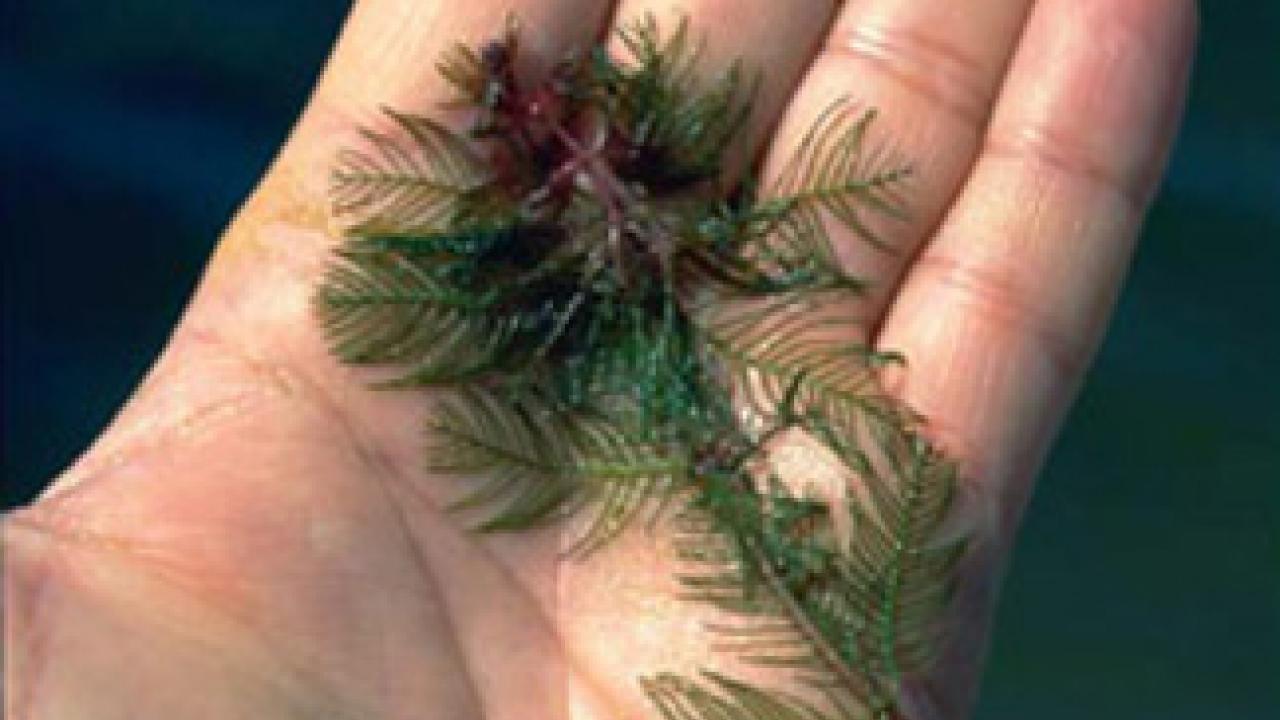Weed specialists are never off duty -- even when they are fishing. While trout fishing in the Fall River in Shasta County, weed scientist Joe DiTomaso noticed Eurasian watermilfoil in the water.
"In the areas that had this exotic plant, there were few fish, and the guide indicated that fishing was very poor in those areas," said DiTomaso, a UC Cooperative Extension specialist in plant sciences at UC Davis.
Fall River is a world-renowned trout fishery nestled in the high country between Mount Shasta and Mount Lassen. Almost entirely spring-fed, the Fall River winds for 16 miles, usually through private agricultural land. In August 2003, Eurasian watermilfoil infestations slowed the river's water flow and flooded 300 acres of grazing land when a levee collapsed.
Since its introduction into the United States, this submerged aquatic plant has spread throughout many rivers and reservoirs. The plant is native to Europe, Asia, northern Africa, and also occurs in Greenland. In North America, Eurasian watermilfoil is found from Florida to Quebec in the East, and California to British Columbia in the West. The attractive plant has feathery underwater foliage and was once commonly sold as an aquarium plant. Milfoil reproduces rapidly and can infest an entire lake within two years of introduction.
Milfoil can form thick underwater stands of tangled stems and vast mats of vegetation on the water's surface, especially in shallow, nutrient-rich water. These mats can limit boating, swimming and fishing. The plant can disrupt the ecology of a water body by crowding out important native aquatic plants needed to provide food for a healthy fishery.
Since Eurasian watermilfoil appears to rely heavily on sediment-based nutrients for growth, DiTomaso and two others -- Dave Spencer, a scientist with the Agricultural Research Service of the U.S. Department of Agriculture, and Thaddeus Hunt, a UC Davis agronomy and horticulture graduate student -- compared the differences in sediment nutrient levels in infested and uninfested sites in the river to predict the areas that would be susceptible to invasion. The study, by identifying environmental factors, could lead to enhanced capabilities for preventing new invasions in wildland aquatic habitats.
Hunt measured the seasonal change of carbohydrates in Eurasian milfoil root crowns and shoots to optimize the success of plant harvest techniques and reduce the need for herbicide treatments.
"The low point in root crown carbohydrates can be used to determine the best timing for mechanical control efforts since plants will have less energy reserves to recover from cutting," he said.
In late summer and fall, the plants become brittle and naturally break apart. These fragments float to other areas, sink, and start new plants. Milfoil will also grow from the fragments that are cut off by boats or by other disturbances at any time of year; the primary factor in the weed's spread appears to be boating activity.
"Once the carbohydrate reserves reach their low point, mechanical cutting and harvesting can provide some control of the invasive species by limiting successful recovery of the plant," DiTomaso said. "Even if plants do recover, a subsequent cutting can further deplete the energy reserves. Preliminary results indicate that the best time to cut the milfoil is mid-July to mid-August, but more testing is required.
"Our long-term goal is to better understand what riverbed conditions are likely to lead to the invasion of Eurasian watermilfoil and to determine the most effective timing for control of the invasive species using mechanical methods."
Klunk is a communications specialist with the Statewide Integrated Pest Management Program based at UC Davis.
Media Resources
Dave Jones, Dateline, 530-752-6556, dljones@ucdavis.edu
